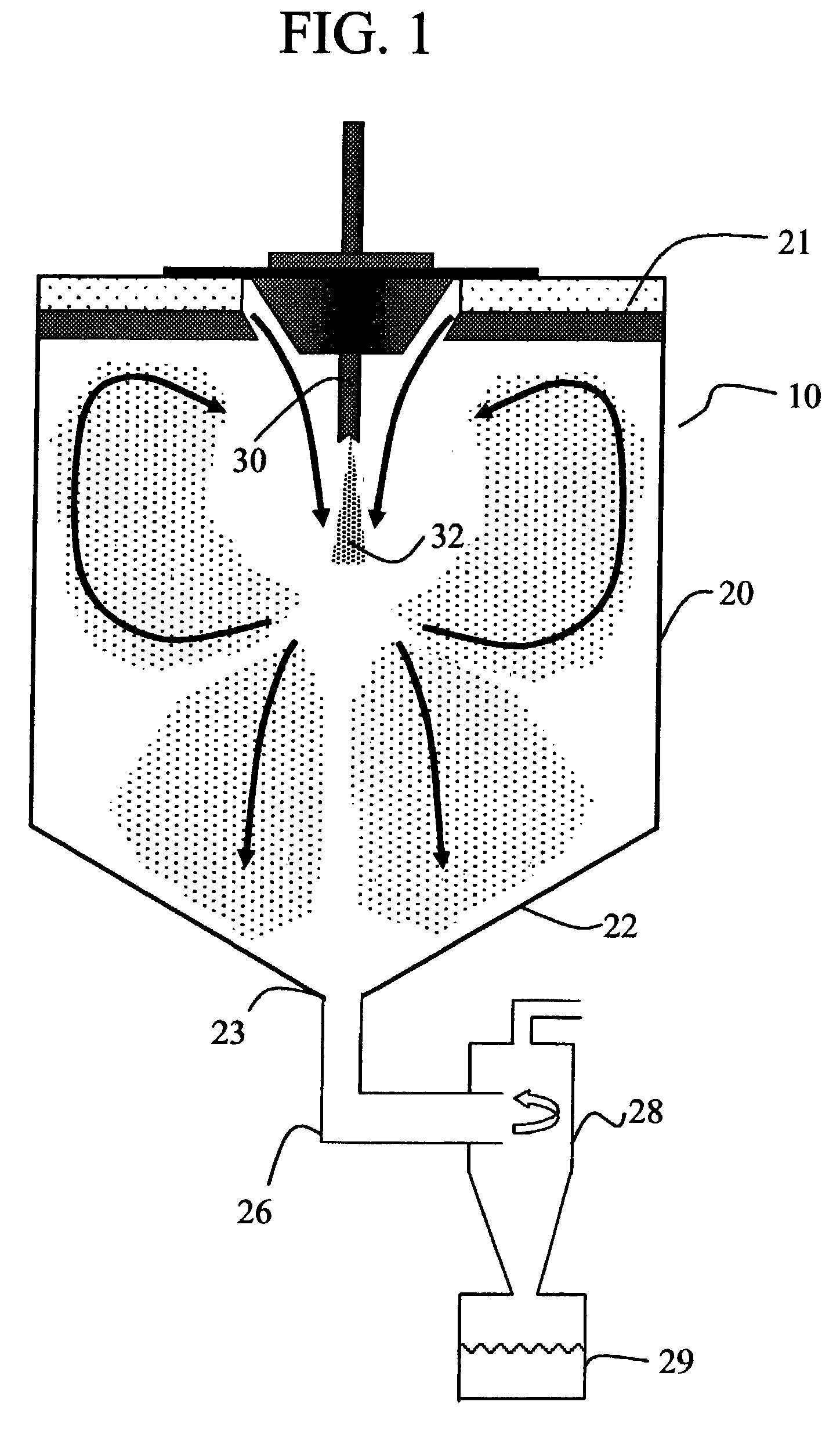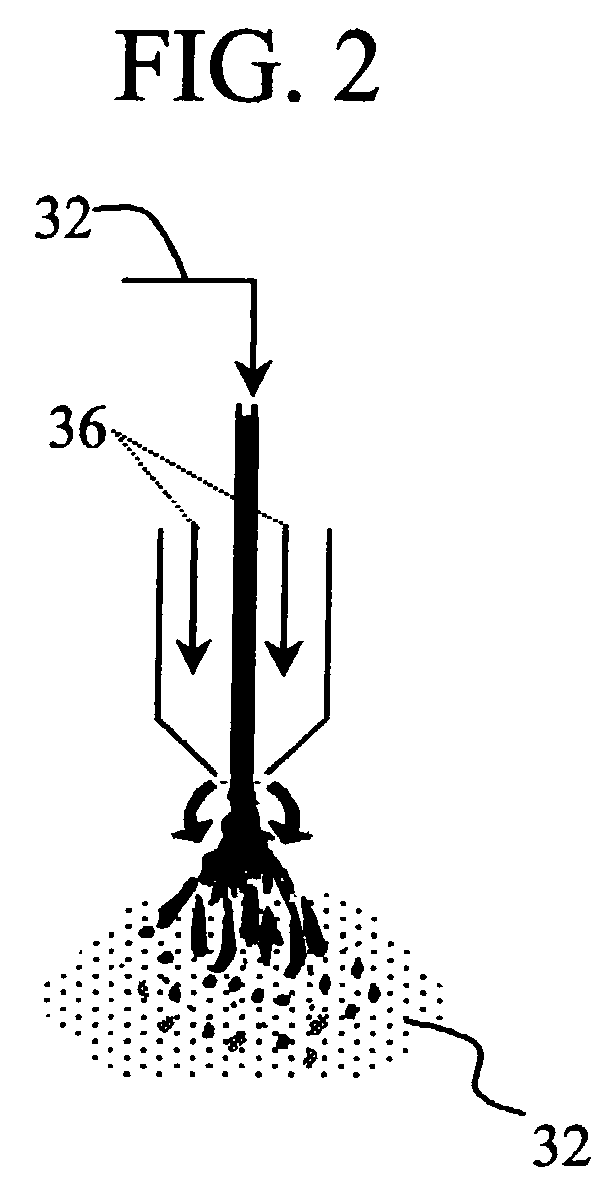Method for making homogeneous spray-dried solid amorphous drug dispersions using pressure nozzles
a technology of amorphous drug dispersions and pressure nozzles, which is applied in the direction of drug compositions, pharmaceutical product form changes, metabolic disorders, etc., can solve the problems of poor flow characteristics, undue experimentation, and less than satisfactory results, so as to achieve the effect of reducing the proportion of fine particles, and increasing the concentration
- Summary
- Abstract
- Description
- Claims
- Application Information
AI Technical Summary
Benefits of technology
Problems solved by technology
Method used
Image
Examples
example 1
[0101]Multiparticulates of a solid amorphous dispersion of the poorly water-soluble drug 4-[(3,5-bis-trifluoromethyl-benzyl)-methoxycarbonyl-amino]-2-ethyl-6-trifluoromethyl-3,4-dihydro-2H-quinoline-1-carboxylic acid ethyl ester (Drug 1) and the amphiphilic polymer hydroxypropyl methyl cellulose acetate succinate (HPMCAS) were prepared by a spray-drying process using a pressure nozzle as follows. Drug 1 was mixed in an acetone solvent together with a medium fine grade of HPMCAS (AQUOT-MF manufactured by Shin Etsu) to form a feed solution comprising 2.5 wt % Drug 1, 7.5 wt % HPMCAS, and 90 wt % acetone. The feed solution was pumped by a high-pressure gear pump (Z-Drive 2000 from Zenith, Inc. of Sanford, N.C.) to a Niro PSD-1 Spray-Dryer with a liquid feed process vessel and a pressure nozzle of the type shown in FIG. 3 (Model SK 71-16 from Spraying Systems, Inc.). The droplet size produced by this pressure nozzle was determined using a Malvern Particle Size Analyzer with the followin...
examples 2-3
[0113]Spray-dried dispersions comprising 25 wt % Drug 1 and HPMCAS were prepared as in Example 1 except that alternative pressure nozzles from Spray Systems, Inc. and spray-drying conditions were used, as indicated in Table 6.
[0114]
TABLE 6Poly-Sol-DrugmerventNozzleFeedEx.MassMassMassNozzlePressureRateTinToutNo.(g)(g)(g)Type(psi / atm)(g / min)(° C.)(° C.)21504505400SK 76-190 / 14 204105451631504505400SK 71-97 / 7.62051074416
[0115]The properties of the dispersions of Examples 2 and 3 were determined as in Example 1. The results, together with those for Example 1 and Control C1, are summarized in Table 7 and graphically displayed in FIG. 4 and show that the dispersions made using pressure nozzles (Examples 1 to 3) have much larger particle diameters and virtually no fines as compared to the dispersion made using a two-fluid nozzle (Control C1), while providing essentially equivalent dissolution performance. In addition, the dispersions of Examples 1-3 had lower specific volumes than that of C...
example 4
[0117]A solid amorphous dispersion comprising the poorly water-soluble drug 5-chloro-1H-indole-2-carboxylic acid [(1S)-benzyl-3-((3R,4S)-dihydroxypyrroldin-1-yl-)-(2R)-hydroxy-3-oxypropyl]amide (Drug 2) with HPMCAS was made by an SK 80-16 pressure nozzle (Spraying Systems, Inc.) as in Example 1 but with a solvent mixture comprising 5 wt % water in acetone with the conditions given in Table 8. The dispersion of Example 4 contained 50 wt % Drug 2.
[0118]Control C2 (C2) consisted of a solid dispersion of Drug 2 with HPMCAS, spray-dried using a Niro two-fluid external mix spray nozzle of the type shown in FIG. 2, and containing 50 wt % drug. The spray conditions and feed makeup were as noted in Table 8.
[0119]
TABLE 8Poly-Sol-DrugmerventNozzleFeedEx.MassMassMassNozzlePressureRateTinToutNo.(g)(g)(g)Type(psi / atm)(g / min)(° C.)(° C.)42002002263SK 80-145 / 11 1651104416C22502502831Niro39 / 3.7180113432-fluid
[0120]The solubility and physical properties of the dispersions of Example 4 and Control C2 ...
PUM
| Property | Measurement | Unit |
|---|---|---|
| Temperature | aaaaa | aaaaa |
| Temperature | aaaaa | aaaaa |
| Fraction | aaaaa | aaaaa |
Abstract
Description
Claims
Application Information
 Login to View More
Login to View More - R&D
- Intellectual Property
- Life Sciences
- Materials
- Tech Scout
- Unparalleled Data Quality
- Higher Quality Content
- 60% Fewer Hallucinations
Browse by: Latest US Patents, China's latest patents, Technical Efficacy Thesaurus, Application Domain, Technology Topic, Popular Technical Reports.
© 2025 PatSnap. All rights reserved.Legal|Privacy policy|Modern Slavery Act Transparency Statement|Sitemap|About US| Contact US: help@patsnap.com



